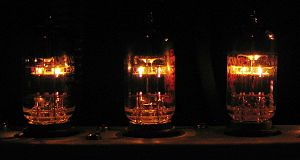This article may be too technical for most readers to understand. (October 2017) |

Tube sound (or valve sound) is the characteristic sound associated with a vacuum tube amplifier (valve amplifier in British English), a vacuum tube-based audio amplifier.[1] At first, the concept of tube sound did not exist, because practically all electronic amplification of audio signals was done with vacuum tubes and other comparable methods were not known or used. After introduction of solid state amplifiers, tube sound appeared as the logical complement of transistor sound, which had some negative connotations due to crossover distortion in early transistor amplifiers.[2][3] However, solid state amplifiers have been developed to be flawless and the sound is later regarded neutral compared to tube amplifiers. Thus the tube sound now means 'euphonic distortion.'[4] The audible significance of tube amplification on audio signals is a subject of continuing debate among audio enthusiasts.[further explanation needed][5]
Many electric guitar, electric bass, and keyboard players in several genres also prefer the sound of tube instrument amplifiers or preamplifiers. Tube amplifiers are also preferred by some listeners for stereo systems.[further explanation needed]
- ^ van der Veen, M. (2005). Universal system and output transformer for valve amplifiers (PDF). 118th AES Convention, Barcelona, Spain.
- ^ Carr, Joseph J. (1996) [1996]. "6-7 Power Amplifiers". Linear IC Applications: A Designer's Handbook. Newnes. p. 201. ISBN 0-7506-3370-0.
It was crossover distortion that was the root of the so-called ʻtransistor soundʼ imputed to early solid-state high fidelity equipment. Bias arrangements are used to overcome crossover distortion.
- ^ Self, Douglas (2013). "10. Output Stage Distortions". Audio Power Amplifier Design (6th ed.). Focal Press. p. 270. ISBN 978-0-240-52613-3.
Unusually, there is something of a consensus that audible crossover distortion was responsible for the so-called ʻtransistor soundʼ of the 1960s.
- ^ Rockwell, Ken (2021-02-28). "Why Tubes Sound Better". KenRockwell.com. Retrieved 2022-01-05.
Tube amplifiers sound better because of the euphonic distortions they add to the music, as well as plenty of other reasons I'll cover below.
- ^ Branch, John (2007). "Postmodern Consumption and the High-Fidelity Audio Microculture". Research in Consumer Behavior. 11: 79–99. doi:10.1016/S0885-2111(06)11004-2. ISBN 978-0-7623-1446-1. (also found in Branch, John D. (2007-05-23). "Postmodern Consumption and the High-Fidelity Audio Microculture". In Russell Belk; Russell Belk Jr.; John Sherry (eds.). Consumer Culture Theory, Volume 11 (Research in Consumer Behavior) (1 ed.). JAI Press. pp. 79–99. ISBN 978-0-7623-1446-1.)
© MMXXIII Rich X Search. We shall prevail. All rights reserved. Rich X Search

